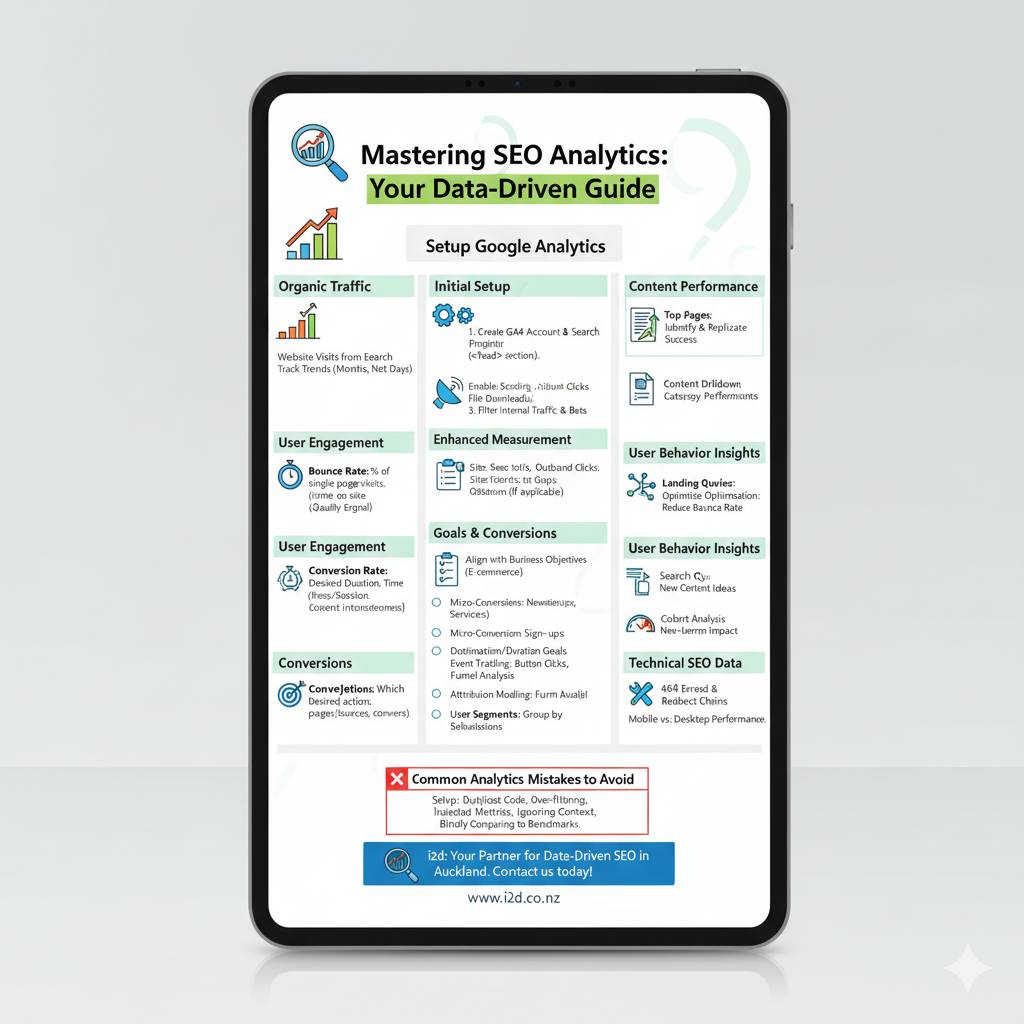Without the right analytics, search engine optimization is like driving with your eyes closed. You could move forward, but you won’t know if you’re going in the right direction or about to hit a wall.
A lot of website owners make the mistake of only making content and building links, completely ignoring the data that could help them improve their SEO strategy. The truth is that analytics shows you the way to SEO success by showing you which strategies work, which pages need work, and where your biggest chances are.
When you set up analytics the right way, you can learn a lot about how well your website is doing, how users interact with it, and how often they convert. You can make smart choices that can greatly boost your search engine rankings and organic traffic based on this information.
This guide will walk you through the essential steps to establish a robust analytics foundation that directly supports your SEO efforts, helping you understand what works, what doesn’t, and how to optimize for better results.
Getting to Know Important Analytics Metrics for SEO Success
Before you start setting things up, you need to know which metrics are important for improving SEO. Not all data points are the same, and if you focus on the wrong ones, you could end up spending a lot of money.
Metrics for Organic Traffic
Organic traffic is when people find your website through search engines without paying for ads. This number is a direct measure of how well your SEO is working, so it should be your main focus. Look at which pages get the most visitors and how they act once they get there to see not only the total amount of organic traffic but also the quality of that traffic.
Monitor organic traffic trends over time rather than focusing on daily fluctuations. Search engines change their algorithms all the time, and traffic patterns can change with the seasons. Look for growth that happens over months, not days.
Signs of User Engagement
The bounce rate shows you how many people leave your site after only looking at one page. A high bounce rate usually means that your content doesn’t match what users are looking for or that your page takes too long to load. But context is important. A blog post that completely answers a question might naturally have a higher bounce rate than a product page.
The average session duration shows how long people stay on your site. Users who stay on your site for longer periods of time usually find your content interesting and useful. Pages with longer average session durations often perform better in search results because search engines interpret this as a quality signal.
Pages per session tells you how many pages a visitor looks at in one visit. More visitors mean that your internal linking strategy is working and that people think your content is connected and useful.
Tracking Conversions
The conversion rate tells you how many of your website’s visitors do what you want them to do. These actions could be buying something, signing up for a newsletter, downloading a resource, or filling out a contact form. Search engines know that high-converting pages are useful to users, so they often rank higher.
Goal completions show you which pages and traffic sources are most helpful in reaching your business goals. You can use this information to improve your best content and find ways to make your worst pages better.

How to Set Up Google Analytics the Right Way
Setting up Google Analytics correctly is the most important part of measuring SEO success. A lot of website owners rush through this process and miss important configuration steps that could give them useful information from GA and Google search console.
Steps to Set Up the First Time
The first step is to set up a Google Analytics account and property for your site. You can choose between Universal Analytics and Google Analytics 4 (GA4). For new setups, GA4 is the better choice because it gives you more complete data and works better with other Google tools.
Make sure you put the tracking code on every page of your website in the right way. Put the code in the header section of your HTML, right after the opening tag <head> tag. if possible. Use browser developer tools or Google Tag Manager to make sure the code works on every page.
Set up your view settings so that your analytics data doesn’t include internal traffic. Make sure to add your IP address and those of your team members so that your own visits don’t mess up the data. Set up filters to get rid of spam referrals and bot traffic that could mess up your metrics.
Improved Setup for Measurement
To automatically track important user interactions without having to add any extra code, turn on enhanced measurement features in Google Analytics. Some of these features are tracking scrolls, clicks on outbound links, file downloads, and video engagement.
Set up site search tracking if your website includes a search function. This information shows you what people are looking for on your site, which can help you find content gaps and ways to improve your site.
If your website has more than one domain or subdomain, set up cross-domain tracking. This makes sure that all of your web presence keeps track of user sessions correctly.
Tracking Goals and Conversions to Learn More About SEO
Goal tracking turns raw analytics data into business intelligence that can be used. If you don’t have clear goals, you’re just measuring activity instead of results.
Setting Goals That Matter
Establish goals that align with your business objectives and SEO strategy. E-commerce sites should keep track of sales, purchases, and views of products. Businesses that provide services might focus on getting people to fill out contact forms, call them, or schedule a consultation.
Make micro-conversions to keep track of smaller but important actions that show users are interested. These could be things like signing up for a newsletter, downloading a resource, or spending a certain amount of time on important pages. Micro-conversions are often the first step toward major conversions and can show how well your SEO is working.
Make sure to set destination goals for important pages like thank-you pages, contact confirmations, and completion screens. Set duration goals to find visitors who are very interested in your content and spend a lot of time reading it.
Tracking Conversions in More Detail
Set up event tracking for certain user actions that don’t involve changing pages. Track button clicks, form submissions, scroll depth, and other engagement signals that search engines might consider when ranking your content.
Use Google Analytics’ attribution modeling to understand how different touchpoints contribute to conversions. This information lets you improve your whole conversion funnel, not just one page.
Set up groups of people based on how they act, where they come from, and how often they convert. These segments let you see how different groups of users interact with your content and find ways to make each group better.

Looking at data to make SEO better
Collecting data is useless if you don’t know how to analyze it and take action. Turn what you learn from your analytics into real SEO changes that get you real results.
Analysis of Content Performance
Find your best pages based on organic traffic, engagement metrics, and conversions. Look at what makes these pages work and use the same ideas on content that isn’t doing well.
The Content Drilldown report will help you see how well different parts of your website are doing. This analysis helps you allocate resources to your most effective content categories and identify areas that need improvement.
Look at how well your landing pages do to see how well they meet user needs. Pages that have a lot of people leaving and not engaging with them may need new content, better internal links, or technical fixes.
Information about how users act
Check out user flow reports to see how people move around your site. Identify common paths that lead to conversions and optimize these routes by improving internal linking and content organization.
Look at the data from search queries to see what words bring people to your site. Look for ways to make new content that uses related keywords or make existing pages easier to find in search engines.
Cohort analysis lets you see how user behavior changes over time. This information helps you see how changes to SEO and content will affect things in the long run.
Technical SEO Information
You can keep an eye on page load times and Core Web Vitals by using analytics. Pages that take a long time to load hurt both user experience and search rankings, so speed optimization is an important SEO factor.
Keep an eye on 404 errors and redirect chains that could be hurting your search results. Use analytics data to find and fix technical problems that might be hurting your rankings.
Analyze mobile versus desktop performance to ensure your website provides excellent user experience across all devices. For SEO success, this analysis is even more important because of mobile-first indexing.
Things to Avoid When Using Analytics
Even marketers who have been doing it for a long time can make mistakes with analytics that hurt their SEO. Stay away from these common mistakes to keep your data correct and useful.
Mistakes in Setup and Configuration
Don’t put more than one analytics code on the same page because this will make your metrics less accurate by adding duplicate data. If you need to, use Google Tag Manager to handle more than one tracking code.
Avoid filtering out too much data from your analytics reports. It’s important to get rid of spam and internal traffic, but too much filtering can hide useful information about how users act and how well the site works.
Don’t ignore view settings and permissions. Make sure that your team members have the right levels of access and that your data sharing settings are in line with your business needs and privacy policies.
Mistakes in Analysis and Interpretation
Don’t give in to the urge to make decisions based on short-term changes in data. Changes to SEO can take weeks or even months to have their full effect, so look at long-term trends instead of daily changes.
Don’t ever look at metrics by themselves. A page with a high bounce rate might seem bad at first, but if it’s a contact page that gives phone numbers and addresses, it can lead to offline conversions.
Avoid comparing your analytics data to industry averages without considering your specific context. Your audience, industry, and business model all make patterns that might not match up with general benchmarks.
Make data-driven decisions to change your SEO strategy.
Setting up analytics correctly gives you a solid base for SEO success that builds on itself over time. You can make smart choices that always improve your search performance if you know what content your audience likes, what keywords bring in useful traffic, and what technical factors affect your rankings.
Keep in mind that setting up analytics isn’t something you do once. Your data will stay accurate and useful as your website and business grow if you do regular maintenance, change your goals, and improve your reports.
The money you spend on setting up analytics correctly will pay off in better search rankings, a better user experience, and more conversions. You can start using these tips right away, and you’ll start to see improvements in your SEO performance in a few weeks.
Are you ready to improve your SEO analytics? At i2d, we help businesses put in place full analytics plans that lead to real SEO improvements. Our team can help you set up, configure, and improve your analytics infrastructure so that it has the best effect on SEO. Get in touch with us today to find out how data-driven SEO can change the way you look online.



